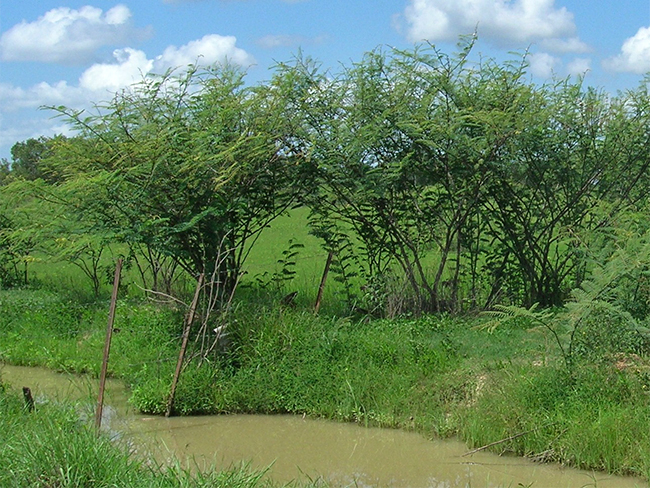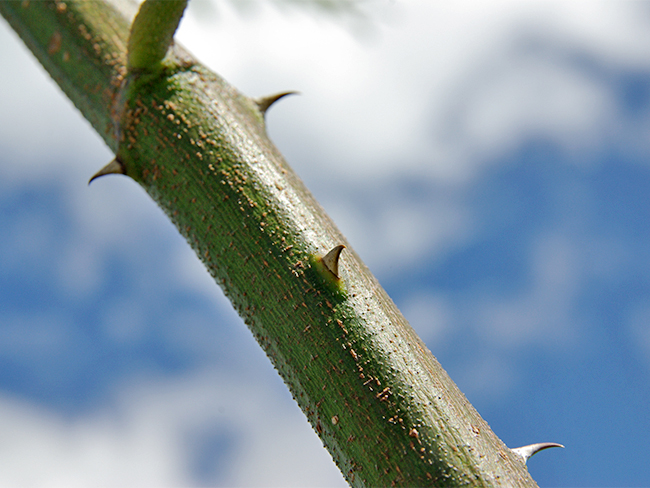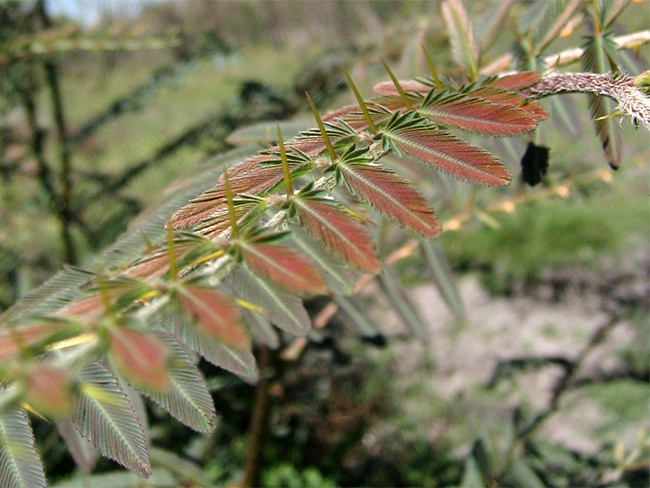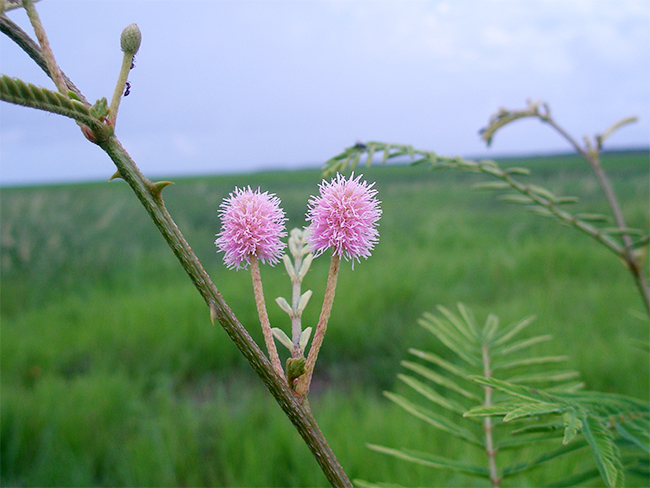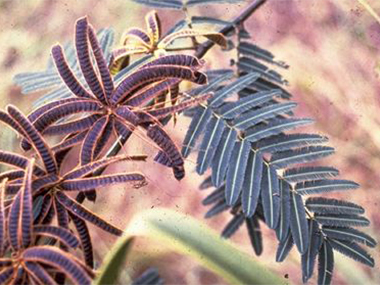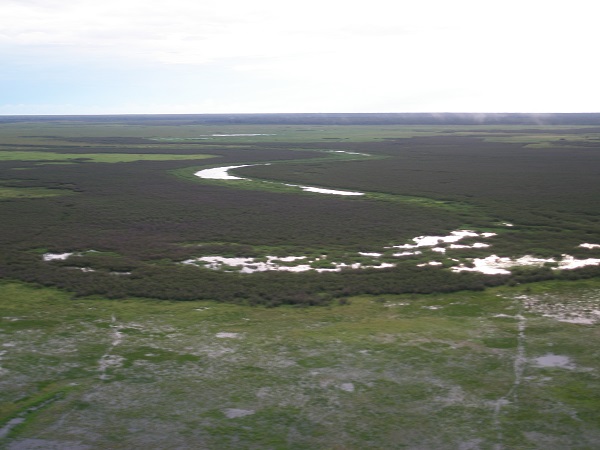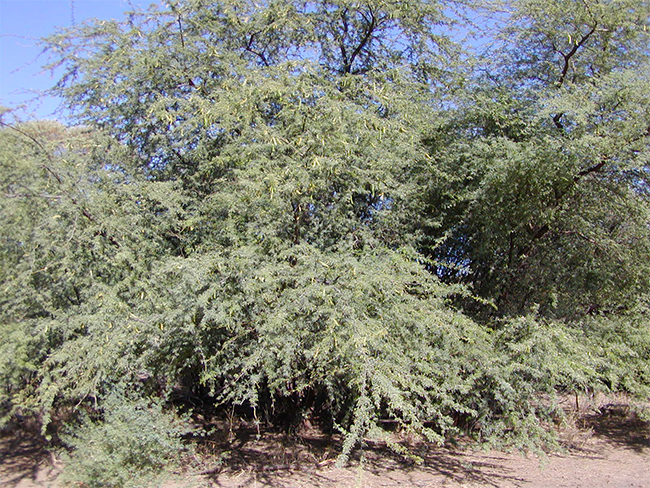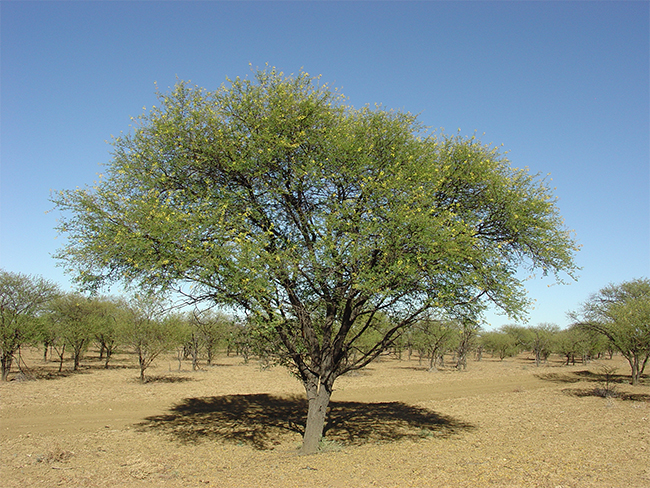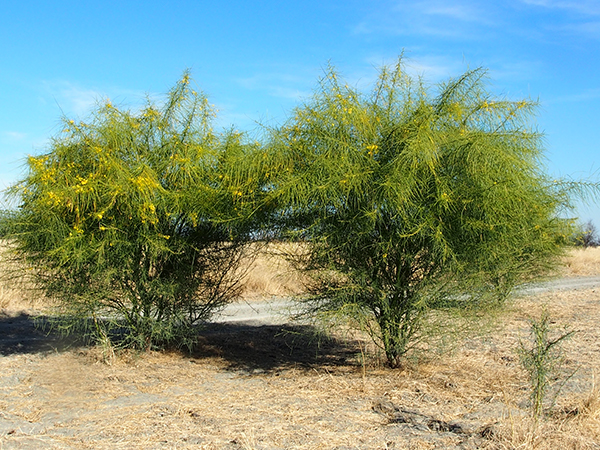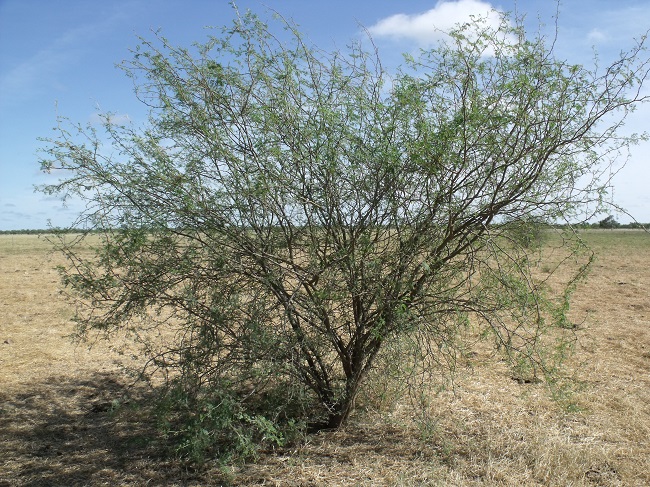Mimosa
Scientific name: Mimosa pigra
Declaration status: Class A except in areas where it is classified as Class B
Mimosa has a statutory weed management plan which outlines the legal requirements for control.
Go to Territory Stories website and read:
- statutory weed management plan
- discussion paper: weed management plans for mimosa and bellyache bush 2023 - 2033.
You can also read the mimosa declaration zone map PDF (547.0 KB).
Mimosa is a Weed of National Significance. For more information, go to the Weeds Australia website.
Mimosa is native to tropical America from Mexico to northern Argentina.
It was deliberately introduced to the Northern Territory (NT) in the late 1800s as an ornamental curiosity.
Since then, it has spread across 15 catchments and onto 3 islands in the NT.
In suitable conditions mimosa can form vast monocultures.
Its spread has negatively impacted wetland ecosystems, pasture production, conservation land management and social and cultural land use.
In Australia
There are 2 known occurrences of mimosa in Australia outside of the NT:
- one at Lake Proserpine in eastern Queensland
- one in the East Kimberley near Kununurra (WA).
Both of these outbreaks are under active management.
In the NT
In the NT, mimosa is particularly invasive on floodplains, wetlands and riparian habitats.
Mimosa has become well established in many river systems across the Top End of the NT, including:
- Fitzmaurice
- Daly
- Reynolds
- Finniss
- Adelaide
- Mary
- East and South Alligator Rivers.
Smaller, satellite infestations have been found on the:
- Arafura Swamp in Arnhem Land
- Melville Island
- Croker Island
- Phelps River.
Impact
It is estimated that up to 140,000 hectares of land in the NT, 10% of the Territory’s wetlands, is already impacted by mimosa.
It has the potential to spread across wetland areas right across northern Australia.
The total area at risk from mimosa infestation in Australia is estimated to be up to 4,600,000 hectares.
Mimosa can have all of the following impacts:
- forms dense, thorny, monospecific thickets up to 6m tall
- prevents access to humans and animals and restricts mustering
- restricts harvesting of bush food by Indigenous people
- takes over and replaces grasslands
- reduces carrying capacity of valuable floodplain country
- harbours feral animals.
Identification
You should use this as a guide. There may be other plants or weeds that look similar.
- single prickly stem when young, branched prickly bush when mature, up to 6m tall
- stem is greenish in young plants, becomes woody as the plant matures
- stem prickles are 0.5cm to 1cm long
- fern-like green leaves made up of many fine leaflets, occur in opposite pairs along branches and fold together at night, when touched or when water stressed
- flower heads are round fluffy balls composed of up to 100 small pink to mauve flowers
- each flower head produces a cluster of 10 to 20 seed pods
- seed pods are 6cm to 8cm long, turn brown when mature and break into segments
- seeds within the pods are oblong, brown or green and flattened and covered in fine hairs.
View a 3D interactive model of this weed below.
© Regional NSW through NSW DPI Invasive Species Biosecurity
Model created by Rachel Klyve
To find out more, get the mimosa weed note on the Department of Lands, Planning and Environment website.
If you're unsure, contact the Weed Management Branch.
Similar looking plants
The following plant species look similar to mimosa:
Mesquite (Prosopis spp.) is native to North and South America. Severe mesquite infestations can reduce the production of native and introduced pasture species by up to 90%.
Find out more about mesquite.
Prickly acacia (Vachellia nilotica) is native to the tropics and subtropic of Africa, Pakistan, India and Myanmar. It is a thorny, umbrella-shaped single stemmed tree.
Find out more about prickly acacia.
Parkinsonia (Parkinsonia aculeata) is native to central and South America, Mexico and southern USA. It infests nearly one million hectares and threatens the agriculture and environmental values over three quarters of the Australian mainland.
Find out more about parkinsonia.
Mimosa bush (Acacia farnesiana) is native to Central and South America. It is a rounded shrub or small tree that forms thorny thickets that hinder mustering and stock access to water. It is not a declared weed in the NT.
Read the what prickle bush is that? guide PDF (85.5 KB) to help you to identify a prickle bush that might be mimosa.
Control
A strategic, integrated and collaborative approach to mimosa management is essential.
Extensive projects have been implemented involving Indigenous land managers, the pastoral sector and the Territory Government. A range of biological control agents have been released as part of an integrated management program in the NT, some of which have proven very successful.
Chemical control
The best time to treat mimosa with foliar spray is from January to February. When basal barking the best time is from July to November, and when using granular application the best time is from November to December. Below is a list of treatment methods that can be used.
You can also get the mimosa management guide PDF (5.5 MB). The recommended printing size is A3.
| Chemical and concentration | Rate | Situation, method and notes |
|---|---|---|
|
Tebuthiuron Various trade names | 1g / m2 |
Seedling or adult (individuals or infestation): Granulated herbicide - ground applied Do not use within 30m of desirable trees or apply to continuous area > 0.5 ha Do not use if fire is eminent Apply when there is soil moisture or prior to rain |
|
Fluroxypyr 200 g/L Various trade names |
300mL / 100 L 3 L / 60L water / ha 1:60 (diesel) |
Seedling or adult (individuals or infestation): Foliar application when actively growing Wetting agent Uptake® required – 500 ml / 100 L Seedling or adult (infestations): Aerial control Seedling or adult: Basal bark or cut stump application method Foliar application when actively growing |
| Fluroxypyr 333 g/LStarane® Advanced |
180ml / 100 L 1.8 L / 60 L water / ha |
Seedling or adult (individuals or infestation): Foliar application when actively growing Wetting agent Uptake® required – 500 ml/ 100 L Seedling or adult (infestations): Aerial control |
|
Metsulfuron-methyl Various trade names | 60g / 60 L water / ha |
Seedling or adult (infestations): Aerial control Non-ionic wetting agent required 100 ml / 100 L |
|
Dicamba Various trade names |
6 L / ha 400mL / 100 L |
Seedling or adult (infestations): Aerial control – Use the wetting agent LI700® Seedling or adult (individuals or infestation): Foliar application when actively growing |
|
Glyphosate Various trade names | ratio 1:1 of water |
Seedling or adult (individuals or infestation): Cut stump |
- Foliar spray: A fine spray with low application pressure enables good coverage of the whole plant.
- Basal bark: This method involves spraying around the whole stem up to 300mm from the ground.
- Pellet granular: Granular chemicals are scattered on the ground around the weed.
- Cut stump: The plant is cut off low to the ground and chemicals are applied to the exposed surface of the stump.
Non-chemical control
Hand pulling and grubbing
Weeds, including their roots, are physically pulled out of the ground by hand or using hand tools. This is an effective method of control for individual weeds and recent outbreaks that haven’t released seeds yet, but it requires a lot of labour.
Bulldozing
Bulldozers, chopper rollers or graders are used to clear large weed infestations. This leaves large areas of soil exposed so follow up control or revegetation should be considered.
Fire
Fire as a management technique is most effective when it is used together with other methods. It is useful for mass seedling control if there is a sufficient fuel load.
Biocontrol
Since mimosa biocontrol research began in 1979, 15 different agents (13 insects and 2 fungal pathogens) have been released against it. Currently there are nine agents actively working to reduce mimosa growth, spread and seed production.
Read the statutory weed management plan to find out about the mimosa biocontrol program.
Spread
Mimosa reproduces via seeds. A single plant can produce 200,000 seeds annually.
Seeds can then be spread by:
- water
- machinery
- vehicles
- animals
- people.
Most seeds will germinate with first rains, however the seed's tough outer coating means the seed can remain dormant for many years (up to 20 years in sandy soils).
Spread prevention
You can prevent the spread of mimosa by doing all of the following:
- avoid seeding plants when fishing and boating
- remove mud that may contain seeds from boats and vehicles before moving to new location
- map infestations to help develop a management plan
- control minor infestations, isolated outbreaks or seedlings first
- prioritise control along drainage lines, creeks and dams
- use fencing to control stock and feral animals in areas where there are mature pods
- quarantine stock when moving from infested paddocks to clean paddocks - seeds can take up to six days to pass through an animal
- keep a healthy and competitive pasture through managing the impact of grazing, feral animals and fire
- avoid pasture disturbance around mimosa infestations to limit mimosa seed germination and also in mimosa free areas to limit mimosa establishment
- avoid driving through infested areas
- designate wash down areas and actively work to prevent contamination of clean areas
- monitor areas that you have treated and watch for re-infestations.
Give feedback about this page.
Share this page:
URL copied!
